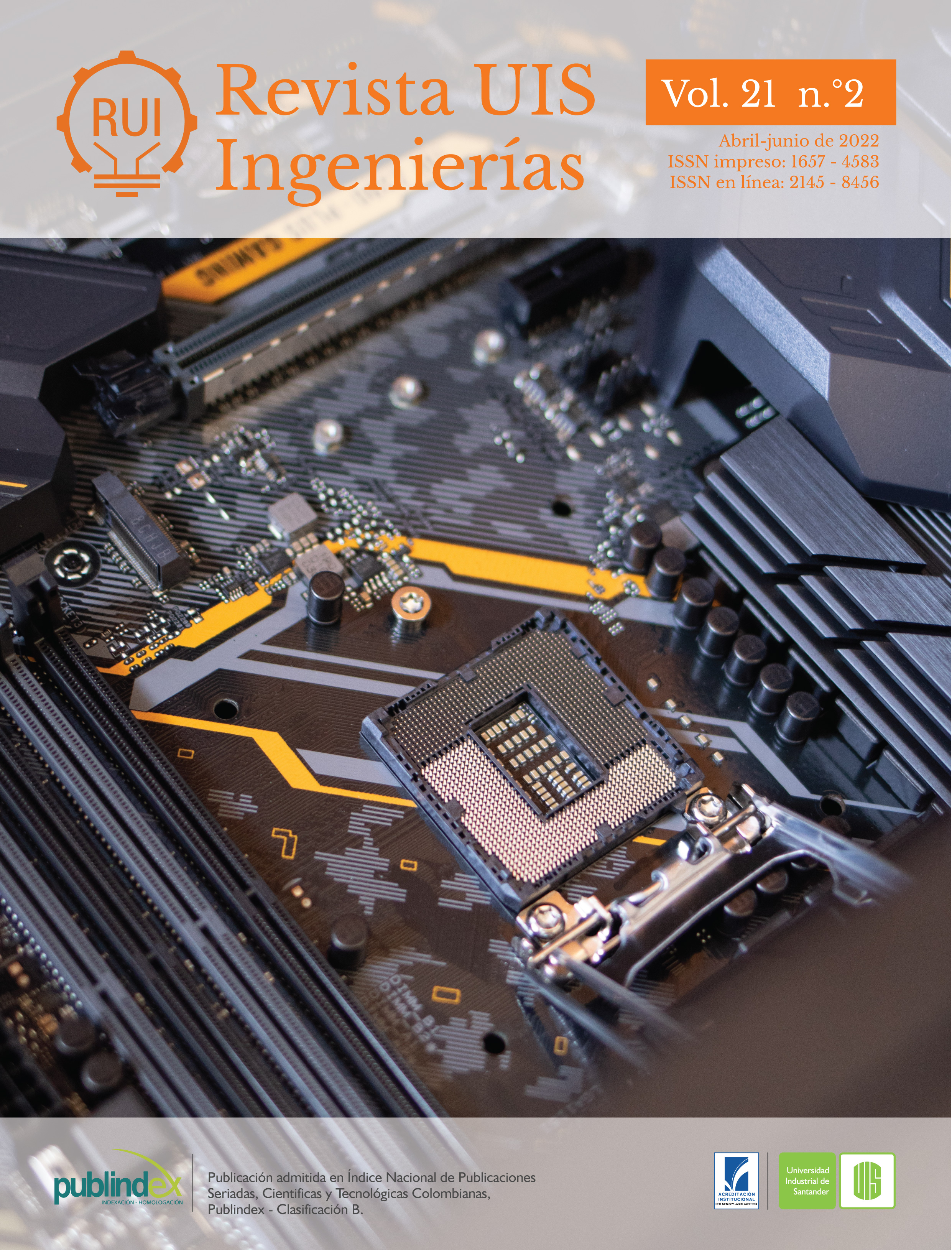Structural analysis of the main deck of a platform supply vessel with a crawler crane
Published 2022-04-05
Keywords
- platform supply vessel,
- main deck,
- crawler crane,
- Von Mises stress,
- allowable stress
- finite element method ...More
How to Cite
Copyright (c) 2022 Revista UIS Ingenierías

This work is licensed under a Creative Commons Attribution-NoDerivatives 4.0 International License.
Abstract
Support vessels for platforms in the oil industry have operation versatility and capacity for structural modification. This article presents a proposal for the installation of a crawler crane on the main deck of a platform support vessel, which will carry out offshore maintenance operations. This proposal includes the results of the structural analysis of the main deck, considering its reinforcement with two NVA36 beams. This structural analysis incorporates the integrity of the main deck, taking into account the crane and loads through finite element method (FEM) models. The obtained results show that the main deck requires the proposed reinforcement to decrease the maximum stresses of von Mises up to 218.71 MPa for the structure of the main deck and 201.67 MPa for the reinforcement beams. These maximum stresses do not exceed the allowable and yield stresses of the main deck material. The reinforcement of the main deck that supports crawler crane allows safe operation of the offshore support vessel.
Downloads
References
- J. A. J. Rodríguez Morales, “Análisis de estabilidad e hidrodinámico de una plataforma SPAR en aguas profundas del Golfo de México”, trabajo de fin de grado, Universidad Veracruzana, Veracruz, 2020.
- J. K. Paik, “Ultimate limit state performance of oil tanker structures designed by IACS common structural rules”, Thin-Walled Struct., vol. 45, pp. 1022-1034, 2007, doi: https://doi.org/10.1016/j.tws.2007.07.002
- S. Lee, S. Lee, S.-D. Kwon, “Effects of Topside Structures and Wind Profile on Wind Tunnel Testing of FPSO Vessel Models”, J. Mar. Sci. Eng., vol. 8, 422, 2020, doi: https://doi.org/10.3390/jmse8060422
- B. N. Khudhur, “Finite element analysis of the boom of crane loaded statically”, Eng. Technol. J., vol. 31, 1626-1639, 2013.
- J. Krukowski, A. Maczyński, “Application of the rigid finite element method for modelling an offshore pedestal crane”, Arch. Mech. Eng., vol. 60, 451-471, 2013.
- Crane Group, “Manitowoc model 555 Product Guide”, [En línea]. Disponible en: https://cranenetwork.com/uploads/specs/krzlhtcycictn3ydmanitowoc_555_150-ton_crawler_crane_network.pdf
- API, Offshore Pedestal-mounted Cranes: API Specification 2C”, 7th ed. USA: American Petroleum Institute, 2012.
- SESAM DNV, “SESAM Software", 2022, [En línea]. Disponible en: https://www.dnv.com/software/products/sesam-products.html
- DNV-GL, “Rules for classification: Ships-DNVGL-RU-SHIP Pt.3 Ch.7. Finite element analysis”, 2020, [En línea]. Disponible en: https://rules.dnv.com/docs/pdf/DNV/RU-SHIP/2020-07/DNVGL-RU-SHIP-Pt3Ch7.pdf
- Manitowoc, “Ground Bearing Pressure Estimator”, 2022, [En línea]. Disponible en: https://www.manitowocdirect.com/en-GB/Tools/lift-planning/ground-bearing-pressure/Application-Download
- DNV-GL, “Offshore standards, DNVGL-OS-C102. Structural design of offshore ship-shaped units”, 2018, [En línea]. Disponible en: https://rules.dnv.com/docs/pdf/DNV/OS/2018-07/DNVGL-OS-C102.pdf
- MSL Engineering Limited, “Appraisal of API RP 2FPS, Recommended Practice for Planning, Designing, and Constructing Floating Production Systems”, United Kingdom: HSE, 2001, [En línea]. Disponible en: https://www.hse.gov.uk/research/otopdf/2001/oto01006.pdf
- DNV-GL, “Rules for classification: Ships-DNVGL-RU-SHIP Pt.5 Ch.10. Vessels for special operations”, 2020, [En línea]. Disponible en: https://rules.dnv.com/docs/pdf/DNV/RU-SHIP/2020-10/DNVGL-RU-SHIP-Pt5Ch10.pdf
- DNV-GL, “Rules for classification: Ships-DNVGL-RU-SHIP Pt.6 Ch.5. Equipment and design features”, 2020, [En línea]. Disponible en: https://rules.dnv.com/docs/pdf/DNV/RU-SHIP/2020-02/DNVGL-RU-SHIP-Pt6Ch5.pdf
- J. K. Paik, A. K. Thayamballi, “Some recent developments on ultimate limit state design technology for ships and offshore structures”, Ships Offshore Struc., vol. 1, pp. 99-106, 2006, doi: https://doi.org/10.1533/saos.2006.0110
- “Load and Resistance Factor Design (LRFD) Criteria for offshore Structures”, American Bureau of Shipping, Houston, USA, 2016.
- “Rules for classification: Ships-DNVGL-RU-SHIP Pt.3 Ch.11. Hull equipment, supporting structure and appendages”, DNV-GL, 2017, [En línea]. Disponible en: https://rules.dnv.com/docs/pdf/DNV/ru-ship/2017-01/DNVGL-RU-SHIP-Pt3Ch11.pdf
- “Special Profiles & Bulb Flats”, LOSAL, 2022. [En línea]. Disponible en: https://www.losal.es/llanta-con-bulbo/
- “Vessel-Mounted Cranes”, Safe Work Australia, 2015, [En línea]. Disponible en: https://www.safeworkaustralia.gov.au/system/files/documents/1703/vessel-mounted-cranes-information-sheet.pdf
- “DNV GL-Software”, Sesam GenieE, 2022, [En línea]. Disponible en: https://www.dnv.com/services/sesam-modules-for-fixed-structures-1120
- “Rules for classification: Ships-DNVGL-RU-SHIP Pt.3 Ch.6. Hull local scantling”, DNV-GL, 2017, [En línea]. Disponible en: https://rules.dnv.com/docs/pdf/DNV/ru-ship/2017-01/DNVGL-RU-SHIP-Pt3Ch6.pdf
- DNV-GL, “Rules for classification: Ships-DNVGL-RU-SHIP Pt.5 Ch.9. Offshore service vessels”, 2019, [En línea]. Disponible en: https://rules.dnv.com/docs/pdf/DNV/RU-SHIP/2019-07/DNVGL-RU-SHIP-Pt5Ch9.pdf

